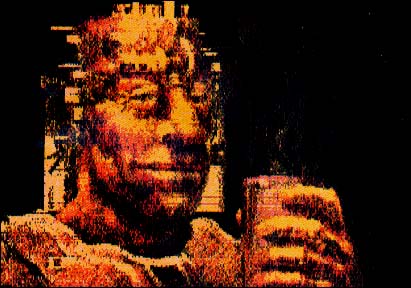 |
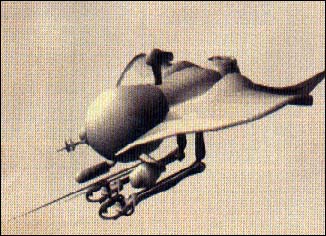 |
PRIME CYBER
Meet Darrel Anderson, who illustrates the future.
BY GAVIN DOUGHTIE
The mighty space station of Port Hesperus... insect-like Venus walkers...the crystal towers of Mars' Labyrinth City. These are the settings for Paul Preuss's bestselling Venus Prime series of science-fiction Mysteries, based on the works of Arthur C. Clarke. They are also illustrations in the unique "infopak" included in each book - illustrations created by artist Darrel Anderson on the Atari ST. Though he was inspired by the space program to pursue science and mathematics, in his last yours of high school Darrel "went through a natural rebellion" and turned to art. Forming Everyman Studios with some of his classmates, among them noted Atari artist Richard Berry, Anderson explored all aspects of art and illustration before he began working with computers. In this interview he tells about his introduction to computers and the details of creating the Venus Prime illustrations.
When did You first start working with computers?
I had seen computers and knew just from looking at them that if I ever got my hands on one I'd probably be hooked, but it didn't happen until around four or four and a half years ago. I had done some work for a guy named Byron Preiss, who packages books for a lot of major publishers. He contacted me about illustrating these interactive computer games, role-playing games. The first one was something called "Breaking Strain".
That was the title of the first Venus Prime book?
Right. That same material somehow came around to be the source for the Venus Prime series. Byron sent me an Atari 800, and that's what I did the game illustrations on. I immediately started fooling around with BASIC and wrote my own little additions to the painting software. I worked primarily with the Koala digitizing pad and whatever software came with that, and another horrible digitizing pad with a two-pivot arm. I think it was the worthlessness of that device that set me out to doing some of my own programming to try to create these images. Anyway, I worked on that project and got a big kick out of it, but I could see right away that I wanted more resolution and color. It was exactly at this point that the ST was being introduced. I bought my ST before it showed up in the shops.
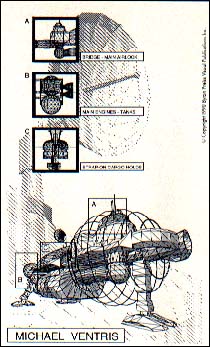 |
Sticking With Atari
So it was a natural Atari Progression?
Yeah. At that point for anybody like me the obvious choice was the ST or the Amiga, but the Amiga cost about twice as much. That was a pivotal factor for me (laughter), so I went ahead and bought the Atari.
Did You start off working with NEOchrome?
I played with what was available, mostly NEOchrome. Shortly after I bought the ST I went out to Boston to spend some time with Richard Berry, and talked him into buying one as well. That was about the time DEGAS came out. I was in Boston when I started working with the first version of DEGAS on that image that won the Antic competition (July 1986 issue of Antic).
The Stone Face?
Right. I got back home just in time to get the machine up and running, because I'd taken it to Boston, put the finishing touches on the image and Federal Express it to Antic at the last possible second. As a result of that, two guys at Antic, Gary Yost and Jack Powell, called me up. First Jack got in touch with me about doing an article (Winter 1986 and Spring 1987 issues of START), and the same day Gary called and said I don't care what Jack has told you but we've got this CAD-3D product coming out, we need some objects for it and this is first priority for you, Darrel." Gary was staking his claim on my time right from the start.
That was the Future Design Disk?
Right.
There wasn't anything like 3D clip art for other computers at the time, was there?
I think we may have started something, because it's happening everywhere now.
How did the Venus Prime project get to you?
That's the same guy, Byron Preiss, packaging. He has a history of bringing graphics into fiction. He was one of the originators of the graphic novel. He did something with the comic artist Jim Steranko in the early seventies. They were paperback format, but comic books. Recently, Byron packaged two books, The Planets and The Universe. They're hardcover collections of essays, short stories and illustrations.
Do they include any of your illustrations?
I have an illustration in the Universebook, an oil painting. Another book in the series called Microversehas one of my computer illustrations done on the Mac.
Are you going to be doing any computer illustrations for other books?
Richard Berry and I are doing a book strictly of computer art and illustration that will be published by Grant Books in 1990.
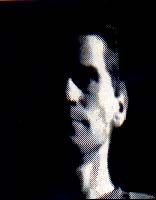 |
| Darrel Anderson by Darrel Ander- son |
The Venus Prime Process
What's the process for creating the Venus Prime illustrations?
As luck would have it, I've known Paul Preuss (the author of the series) for a number of years, long before this project came up. He's a fine author and has several novels of his own out there. What happens is at some point, usually long before the work is even written, he and I will get on the phone and I'll draw out what nifty gadgets may be available to him in the story. He's got a real sharp technical mind, a good mind for the details of how these things should actually function in an acidic environment or whatever it may be. He does a lot of research. I'll throw some sketches at him, and he'll throw some ideas back at me. This goes all the way back to the Everyman Studio. That's how we all learned, because we didn't have higher education. We were intense collaborators. We would literally hand the same canvas or piece of paper back and forth. It comes very naturally to us.
As the Venus Prime series progresses, the illustrations get technically more sophisticated. Were you using Cyber Control to create the objects for the design disks and the Venus Prime books?
Absolutely. The object design and creation aspect of Cyber Control, which in some ways was its weakest or most difficult capability, was what really fascinated me. I wanted to develop my own object-building tools. This was all pre-Cyber Sculpt. CAD-3D was pretty limited in what you could do, and of course the join functions were just a nightmare to sculpt objects with. The Microbots disk, for example, is almost entirely my object-creation tools written in Cyber Control. As I developed the tools, usually at some point one of those books would come up.
In the third book there are illustrations with smooth shading and shadows. What were those rendered on?
This gets into what I think is probably a fairly unique setup. I'm working with an ST/Mac II hybrid system, though it was slightly different at the point I did that book. I wrote my own little rendering package on the ST which did what GDOS was supposed to do for me but never worked, and that is produce resolution-independent, or very high-resolution, object-oriented bitmaps. I was creating these oversize bitmaps on the order of 1200 x 1200 pixels on the Atari, then moving those files over to the Mac and doing a pixel-averaged reduction in such a way that the dither pattern was turned into shades of gray. It's all my own software.
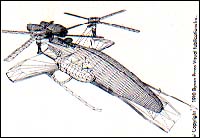 |
Are you going to sell any of these programs?
Right now I'm working on a paint program on the Mac which will probably be my first venture into commercial software. The stuff on the Atari - I was tempted for a while there but it all operated in a bizarre way, and I don't know if I'll ever have the time or energy to make it more acceptable. In essence it required having a monochrome monitor. The large bitmaps were actually created in chunks. The program creates nine panels and moves them to an area of memory one at a time. It was kind of slow and kludgy. What I do at this point on the Atari is simply save what is the equivalent of an object-oriented PICT file on the Mac - in other words, simply a series of commands to draw a triangular shape, filled or outlined or opaque or transparent. Then I render everything on the Mac so I can go straight to grayscale. This little package I wrote on the ST does simple shading much like CAD-3D does, but I can go ahead and generate the 256 gray level shading that the Mac is capable of rendering.
Have you been working this way since the first Venus Prime book?
No. That started with the third one.
The first two were just laser printed from the Atari?
They weren't even laser printed, they were printed with a 24-pin dot matrix. That really does nice work with one of those multi-strike ribbons, like a carbon ribbon for a typewriter. In some ways you can get better-than-laser-printer results.
How have computers influenced your work in general?
CAD-3D is very powerful, especially for a project like book illustrations. You may be doing a number of illustrations that are in the same setting, build the scene only once, and then look at it from anywhere you like. I illustrated a Ray Bradbury story which centers around a kid in his room, so I built the room in CAD-3D and used it as a basic map. It brought me to some unusual camera angles.
Do you have any advice for ST illustrators?
Just get in there and start scribbling and playing and see what it gives you naturally. That is the advice I would give to anybody in any media.
Gavin Doughtie writes and directs for CU Productions in Hollywood, Calif.